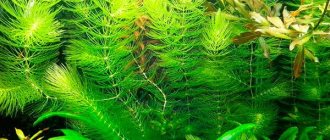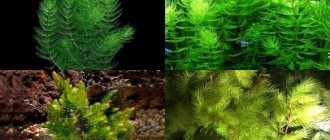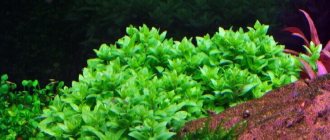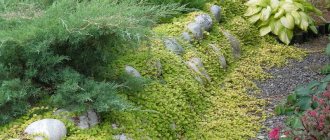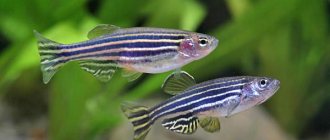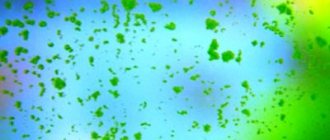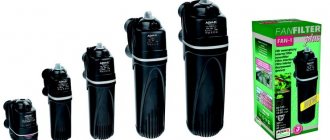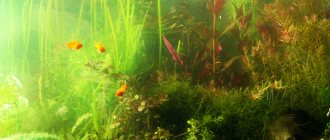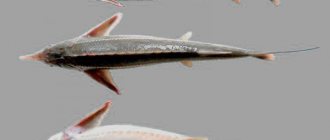The aquarium plant hornwort (Ceratophýllum) is very popular among beginners who want to arrange an underwater world in a separate apartment.
Why? The answer is simple: it is unpretentious, can withstand both high and low water temperatures in the aquarium, and adapts well to lack of lighting.
But the main thing is that it is practically not eaten by the inhabitants of the reservoir.
Description of the plant
Hornwort is a rhizomeless plant. It floats freely in the water column or is attached by stem shoots (rhizoids) to snags and stones at the bottom. The rhizoids are whitish or light green in color and are also covered with dissected foliage. In the silt they absorb nutrients and become fixed.
Thin twisting stems are located in the water and can rise above its surface. Under favorable conditions they grow quite quickly. In just a month, the stems can lengthen by 1 m. The transport function inside the shoot is practically atrophied, so nutrition is carried out by each individual cell on the surface of the plant.
The sessile dissected leaves are divided into narrow thread-like plates. From a distance they resemble a spruce branch. The foliage color is bright green or brown-green. The leaves grow in whorls. The lobes are expanded at the base, their length reaches 4 cm and width – 0.5 mm. At high magnification, small teeth can be seen on the edges of the leaves. The stems and foliage are quite hard as they accumulate lime. If you are careless, they break. The surface of the entire plant is covered with cuticle - a fat-like film that serves as a barrier between water and hornwort.
Flowers bloom right in the water. Small petalless corollas up to 2 mm long are collected into loose panicles. They are fixed in the internode on a short peduncle. Flowers are pollinated directly in the water. After this, small nuts ripen, covered with awl-shaped growths.
Peculiarities
Hornwort is a perennial aquatic plant. Found on all continents except Antarctica. In cultural cultivation it is used for landscaping aquariums and home ponds. Attractive appearance combined with beneficial properties ensure the constant demand for ceratophyllum. Hornwort is universal. This is a decorative element in the design of the aquarium, a spawning phytosubstrate, and a biological filter that actively purifies the water from nitrates and organic matter.
The stems are thin, twisting, bushy, covered with needle-shaped green or brown-green leaves, similar to conifer needles. The dissected leaves resemble horns and surround the stem in the form of a fluffy decorative bunch. Hornwort is freely located in the water column, can partially protrude above the surface, and does not have a root system. Nutrition comes directly from the water to the cells of the leaves and stems. Thread-like stem shoots of rhizoids are attached at the bottom of the aquarium to soil elements - snags, stones, silt.
Flowering occurs in the water column. Loose panicle inflorescences with small (about 2 mm) unisexual flowers on a short peduncle are fixed in the internodes. They are pollinated underwater by streams of water. The fruit of the hornwort is a small nut (up to 5 mm) with spiny growths.
A characteristic feature of this type of aquatic flora is the enveloping of foliage with a cuticle - a thin fat-like shell made of the substance cutin. The cuticle acts as a kind of membrane between the leaves and the aquatic environment in the aquarium, protecting the hydrophyte from being eaten by the inhabitants of the aquarium.
Hornwort species
There are about 30 species of aquarium hornwort.
Plants vary in color, shape and arrangement of leaves, but in general all species are similar in their bushy structure and frequent arrangement of leaves on the stem.
The most common types include:
- Hornwort is dark green. It is distinguished by dark leaves, while most species of this genus have a light green tint.
- Hornwort is light green. It is the most common aquarium species. When light rays hit the thickets of a plant, the leaves acquire a delicate light green tint.
- Cuban hornwort. This species is distinguished by special decorative properties: fluffy foliage, brown stem.
- Mexican Hornwort. It is one of the most unpretentious species of this genus of underwater plants.
Varieties
There are about 30 botanical species of hornwort, but several are used in the aquarium hobby.
- Submerged (aka dark green, underwater, three-axle). It has thin, long reddish stems and dark green, needle-shaped, dissected leaves. Grows in the water column. Can be grown free floating or attached to the ground. In aquarium conditions, the seasonal growth of this species of hornwort is maintained. When the temperature drops in winter, growth slows down, the plant sheds some of its lower leaves (only the tops of the shoots remain) and “lays” to the bottom for the winter.
It has received universal recognition and wide distribution among aquarists all over the planet for its versatility, unpretentiousness, and rapid growth.
- Semi-submerged (light green) hornwort has light green dissected leaves and a branching, brittle stem. It is growing rapidly. In low aquariums it can obscure other green flora and therefore requires constant monitoring of growth. Intense light affects the color of the plant - delicate light green leaves acquire a scarlet tint. It is rarely sold in pet stores in aquatic floristry departments due to the fragility of the stems.
- Mexican. Grows successfully in soft and hard water. It survives in cold (up to 6 degrees) water, and develops well in tropical aquariums with temperatures of +25... +30 degrees. Placed along the side or near the back wall of the aquarium. Decorative compact thickets of Mexican hornwort with 15-20 stems look picturesque.
The disadvantage of this species is the extreme fragility of the stems, which creates significant problems during its transportation and prevents its widespread introduction into aquaculture.
- Cuban (red stem, “fox tail”). It has a strongly branched stem of a purple hue. Internodes are located close to each other, the foliage is fluffy and abundant. The bushy branches are extremely beautiful, shaped like a thick fox tail, which is why this name was assigned to the Cuban hornwort. The peculiarity of this variety is constant year-round growth without any additional tricks.
It has the highest decorative value and the most durable stem of all types.
Benefits of Hornwort in the Aquarium
Hornwort has a number of advantages over other aquatic crops:
- He is easy to care for.
- Easily propagated.
- Purifies aquarium water by trapping food debris and algae on the leaves, thereby preventing them from settling to the bottom.
- It is eaten by many types of fish, especially goldfish, mollies, veiltails, and angelfish.
- It forms dense thickets that become a natural habitat for fry, snails, small fish, as well as a spawning ground.
- It perfectly saturates the water with oxygen, so when growing in small aquariums it allows you to do without an aerator.
- Suitable for all types of aquariums and goes well with other aquatic plants.
- It is good for growing only neglected aquariums - it prevents the active reproduction of algae that feed on organic substances necessary for the life of aquarium inhabitants.
- Under favorable growing conditions, it grows and reproduces quickly.
Breeding methods
It is easier to propagate ceratophyllum at home not by seed, but by vegetative method:
- Cut the long shoot into fragments of 5-15 cm.
- Fix the lower parts of the daughter plants in the ground - press them down with a stone, driftwood or decorative items.
Within 2-3 days, new leaves will appear on the young plants and the shoots will begin to lengthen. To create an imitation of a lush and uniform bush, you can combine several cuttings into one bunch and plant them in the back or side of the aquarium, where direct sunlight does not penetrate.
Conditions for growth and reproduction
If in the natural environment the hornwort loves shaded places, then in the aquarium it requires additional artificial lighting (at least 12 hours a day). A slightly alkaline and soft water environment is ideal. For healthy growth, a temperature of 16 to 28 degrees is required. In such conditions, the leaves of this species will have a healthy dark green color, and the stems will be beautiful and lush.
Usually hornwort is dug into the ground from the rear wall. However, this plant has no roots and can float calmly on the surface, forming green islands.
As for propagation methods, the easiest one can be used for hornwort is cuttings. To do this, you need to take the stem and divide it into small sections 10-15 cm long. Then the cuttings should be planted in the ground, and after two to three days you will be able to see new branches from the main stem.
It should be noted that if all the required conditions are met, hornwort grows even better in an artificial environment than in nature. In addition, it can reach a length of up to 1 m per month.
How to plant?
Most aquarists do not plant hornworts, but leave the new plants to float freely in the pond. But a free-floating plant often grows into a complex nodular formation that cannot be untangled by any means. special suction cups for planting Planting material is carefully attached to them with a fishing line, and the suction cups are fixed to the bottom or walls of the aquarium. This method greatly facilitates subsequent care: it is convenient to remove plants from the container for washing and removing rotten areas.
There is no need to add nutritional supplements to the bottom substrate, since hornworts do not have roots and feed entirely from the aquatic environment.
Aquarium hornwort - care
Whatever one may say, the beauty of the aquarium landscape largely depends on the time spent on the part of the aquarist. The grass for an aquarium, hornwort, does not need to create special conditions, but the neatness and brightness of the greenery will please only with proper care:
- aquarium plants of this type need nitrates, their level will affect the condition of the greenery, but almost always there is no need to additionally saturate the water with nitrates;
- the duration of daylight hours will give the brightness of the greenery, but direct streams of light are destructive for the aquarium plant hornwort;
- the leaves taste bitter, therefore the inhabitants of the aquarium rarely eat the stems; algae of this type are compatible with almost all plants and fish;
- active growth and richness of greenery are observed at a temperature of 20-24°C.
Species diversity of Ceratophyllum
There are some difficulties with the taxonomy of the genus Hornwort (Ceratophyllum). Despite the plant’s long history (almost 300 years), scientists are still playing around with taxonomy. In some data, the genus contains about a hundred species, in others up to 30. Whose data to use is a personal choice. I am impressed by the classification provided by the encyclopedic Internet portal Theplantlist. All information about the nomenclature of modern plants is collected here.
According to the published data, the genus Hornwort contains 4 plant species and 6 subspecies. One form of hornwort is still in question ( Ceratophyllum affine
ZF Troitsk).
Submerged Ceratophyllum demersum
Semi-submerged Ceratophyllum submersum
L.
Five-needle hornwort
Ceratophyllum platyacanthum
Cham.
Hornwort
Ceratophyllum muricatum
Cham.
Why doesn't hornwort grow in an aquarium?
Plants that do not require the active participation of the aquarist can sometimes be quite capricious. The hornwort plant quite successfully greened up the entire aquarium, and then simply turned yellow or dropped its leaves. Such cases are not uncommon. Poor growth occurs due to several reasons:
- too different water parameters in the new aquarium after transplantation;
- the algae became supercooled during transportation;
- low nitrate levels;
- At night, the oxygen level in the water drops significantly.
Diseases, their treatment and prevention
Hornwort is a hardy aquarium species and is rarely susceptible to disease. If tender leaves have been exposed to aggressive lighting and have turned yellow, you must carefully cut off the damaged shoots. If an aquarium becomes infected, hornwort, like other aquarium species, must be thoroughly washed under running water and placed in a separate tank until the aquarium is disinfected. The fungal coating is washed off the plant with a stream of running water, then the stems are disinfected with a light disinfectant solution.
Possible problems
Hornworts are disease resistant and are rarely affected by disease. When exposed to direct sunlight or too aggressive lighting, the delicate leaves turn yellow. When such symptoms appear, it is necessary to eliminate the unfavorable factor and cut off the damaged parts of the plant.
A sharp change in environmental parameters (if there is a need to transplant the bush into another aquarium) can lead to the shedding of leaves, and the bare stem will no longer be able to recover. You can cut off the apical shoots and put them in water, but you will have to throw away the stem.
If a plant infection has entered the aquarium, you need to carefully remove the hornwort and all aquarium flora, rinse carefully under running water and treat with a special light disinfectant. Plants should be placed in a temporary tank to wait out the period of disinfection of the aquarium.
Selecting aquatic flora for an aquarium is not an easy task. Aquarists strive to fill the aquarium not only with plants with high decorative properties, but also with useful properties. In this regard, not every aquatic plant can compare with hornwort. It quickly adapts to a new aquarium and begins to work actively while other plants are in the acclimatization stage.
It actively absorbs carbon dioxide, produces oxygen, and normalizes the nitrogen cycle. The water in aquariums with hornwort remains clean for a long time, since this plant is a biological filter. Remains of organic matter, suspended matter, and silt settle on its thick greenery. All this, with a sufficient amount of oxygen, quickly oxidizes and the water does not become cloudy.
Fluffy greenery, in addition to its aesthetic function, is an ideal spawning substrate and habitat for fish fry.
Among the disadvantages of the plant, there is significant fragility of the stems, as well as the need to constantly monitor its growth in order to promptly eliminate excessive filling of the reservoir with greenery. Any aquarist, even a beginner, can cope with growing hornwort.
Tips for caring for hornwort await you below.
Hornwort is one of the most common plants used in the aquarium hobby.
Its popularity is explained by a number of advantages over other aquatic plants, as well as ease of care and ease of propagation.
We invite you to get to know the hornwort better and learn about the nuances of keeping it in an aquarium.
